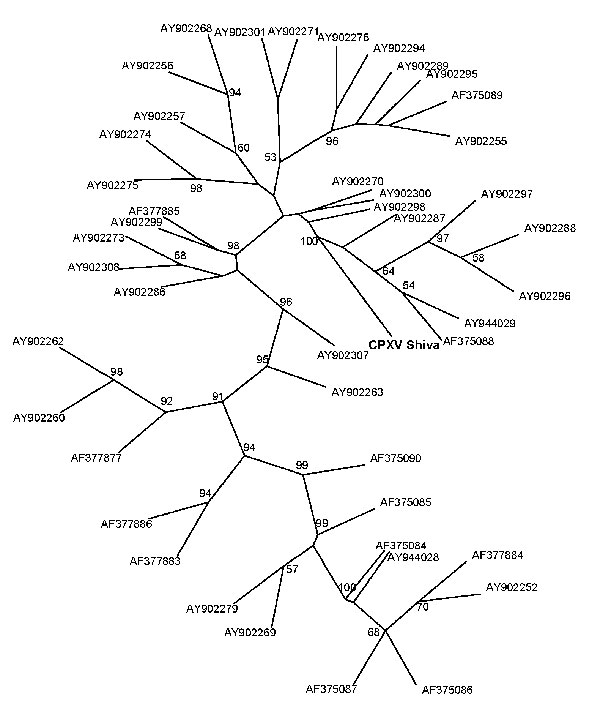Volume 15, Number 5—May 2009
Dispatch
Cowpox Virus Transmission from Pet Rats to Humans, Germany
Figure 2

Figure 2. Phylogenetic tree of the isolated cowpox virus (CPXV) Shiva strain (in boldface; named after pet rat shown in Figure 1, panel A; GenBank accession no. FJ654467), constructed by the maximum-parsimony method based on the partial sequences method based on the hemagglutinin (HA) gene, unrooted. BLAST search (www.ncbi.nlm.nih.gov/blast/Blast.cgi) confirmed the identification of this strain as a CPXV strain with a unique HA gene sequence. The highest identity of 98.1% was found for strain cowHA72 (accession no. AY902300), a CPXV strain isolated from an elephant in the Netherlands. Bootstrap values >50% are shown. Additional unique CPXV strains shown for comparison, by accession number: AY902307 (cowHA35e), AY902301 (cowHA82), AY902299 (cowHA70), AY902298 (cowHA68), AY902297 (cowHA52), AY902296 (cowHA51), AY902295 (cowHA48), AY902294 (cowHA46), AY902289 (cowHA47), AY902288 (cowHA41), AY902287 (cowHA40), AY902286 (cowHA37), AY902279 (cowHA76), AY902276 (cowHA23), AY902308 (cowHA38), AY902275 (cowHA22), AY902274 (cowHA21), AY902273 (cowHA81), AY902271 (cowHA19), AY902270 (cowHA18), AY902269 (cowHA17), AY902268 (cowHA16), AY902263 (cowHA15), AY902262 (cowHA34), AY902260 (cowHA13), AY902257 (cowHA09), AY902256 (cowHA07), AY902255 (cowHA63), AY902252 (cowHA73), AY944029 (CPV90_ger2), AY944028 (CPV91_ger3), AF377886 (cowpox virus), AF377885 (cpv-922-99), AF377884 (cpv-867-99b), AF377883 (cpv-667-94b), AF377877 (cpv-1218-00), AF375090 (cpx-ep-2), AF375089 (cpx-brt), AF375088 (cpx-90-5), AF375087 (CPX-90-1), AF375086 (cpx-89-5), AF375085 (cpx-89-4), and AF375084 (cpx-89-1).